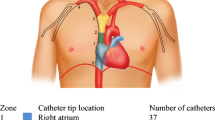Abstract
Purpose: To study the cost and impact on patient management of the routine performance of chest radiographs in patients undergoing imaged-guided central venous catheter insertion.
Methods: Six hundred and twenty-one catheters placed in 489 patients over a 42-month period formed the study group. Catheters were placed in the right internal jugular vein (425), left internal jugular vein (133), and subclavian veins (63). At the end of the procedure fluoroscopy was used to assess catheter position and check for complications. A postprocedural chest radiograph was obtained in all patients.
Results: Postprocedural chest fluoroscopy showed no evidence of pneumothorax, hemothorax, or mediastinal hematoma. Inappropriate catheter tip position or catheter kinks were noted with 90 catheters. These problems were all corrected while the patient was on the interventional table. Postprocedural chest radiographs showed no complications but proximal catheter tip migration was noted in six of 621 catheters (1%). These latter six catheters required further manipulation. The total technical and related charges for the postprocedural chest radiographs in this series were estimated at £15,525.
Conclusion: Postprocedural chest radiographs after image-guided central venous catheter insertion are not routinely required. A postprocedural chest radiograph can be performed on a case-by-case basis at the discretion of the interventional radiologist.
Similar content being viewed by others
References
Lund GB, Trerotola SO, Scheel PF Jr, Savader SJ, Mitchell SE, Venbrux AC, Osterman FA Jr (1996) Outcome of tunneled hemodialysis catheters placed by radiologists. Radiology 198:467–472
Trerotola SO, Johnson MS, Harris VJ, Shah H, Ambrosius WT, McKusky MA, Kraus MA (1997) Outcome of tunneled hemodialysis catheters placed via the right internal jugular vein by interventional radiologists. Radiology 203:489–495
Denny D (1993) Placement and management of long-term central venous access catheters and ports. AJR 161:385–393
Teichgraber UKM, Benter T, Gebel M, Manns MP (1997) A sonographically guided technique for central venous access. AJR 169:731–733
Millner MR, Kerns SR, Hawkins IF Jr, Sabatelli FW, Ross EA (1995) Tesio twin dialysis catheter system: A new catheter for hemodialysis. AJR 164:1519–1520
Robertson LJ, Mauro MA, Jaques PF (1989) Radiologic placement of Hickman catheters. Radiology 170:1007–1009
McDowell DE, Moss AH, Vasilakis C, Bell R, Pillai L (1993) Percutaneously placed dual lumen silicone catheters for long-term hemodialysis. Am Surg 59:569–573
Bour ES, Weaver AS, Yang HC, Gifford RRM (1990) Experience with the double lumen silastic catheter for hemoaccess. Surg Gynecol Obstet 171:33–39
Herbst CA Jr (1978) Indications, management, and complications of percutaneous subclavian catheters: An audit. Arch Surg 113:1421–1425
Koski EM, Suhonen M, Mattila MA (1992) Ultrasound-facilitated central venous cannulation. Crit Care Med 20:424–426
McIntyre AS, Levison RA, Wood S, Phillips RK, Lennard-Jones JE (1992) Duplex Doppler ultrasound identifies veins suitable for insertion of central feeding catheters. J Parenter Enteral Nutr 16:264–267
Pozzoli M, Galli F, Capomolla S, Forni G, Cobelli F, Tavazzi L (1994) Utilita delle tecniche ultrasonographiche nell’incannulazione della vena gingulaure internal in pazienti cos insufficienza cardia cronia. G Ital Cardiol 24:1211–1221
Yonei A, Nonoune T, Sari A (1986) Real-time ultrasonic guidance for percutaneous puncture of the internal jugular vein. Anaesthesiology 64:830–831
Mansfield PF, Hohn DC, Fornage BD, Gregurich MA, Ota DM (1994) Complications and failures of subclavian-vein catheterization. N Engl J Med 331:1735–1738
Morton JE, Jan-Mohamed RMI, Barker HF, Milligan DW (1991) Percutaneous insertion of subclavian Hickman catheters. Bone Marrow Transplant 7:39–41
Barrios CH, Zuke JE, Blaes B, Hirsch JD, Lyss AP (1992) Evaluation of an implantable venous access system in a general oncology population. Oncology 49:474–478
Brothers TE, Von Moll LK, Niederhuber JE, Roberts JA, Walker-Andrews S, Ensminger WD (1988) Experience with subcutaneous infusion ports in three hundred patients. Surg Gynecol Obstet 166:295–301
Carde P, Cosset-Delaigue MF, LaPlanche A, Chareau I (1989) Classical external indwelling central venous catheter versus totally implanted venous access systems for chemotherapy administration: A randomized trial in 100 patients with solid tumors. Eur J Cancer Clin Oncol 25:939–944
Slater H, Goldfarb IW, Jacob HE, Hill JB, Srodes CH (1985) Experience with long-term outpatient venous access utilizing percutaneously placed silicone elastomer catheters. Cancer 56:2074–2077
Gallieni M, Cozzolino M (1995) Uncomplicated central vein catheterization of high risk patients with real time ultrasound guidance. Int J Artif Organs 18:117–121
Lameris JS, Post PJ, Zonderland HM, Gerritsen PG, Kappers-Klunne MC, Schutte HE (1990) Percutaneous placement of Hickman catheters: Comparison of sonographically guided and blind techniques. AJR 155:1097–1099
Skolnick ML (1994) The role of sonography in the placement and management of jugular and subclavian central venous catheters. AJR 163:291–295
Burnett AF, Lossef SV, Barth KH, Grendys EC, Johnson JC, Barter JF, Barnes WA (1994) Insertion of Groshong central venous catheters utilizing fluoroscopic techniques. Gynecol Oncol 52:69–73
Craft PS, May J, Dorigo A, Hoy C, Plant A (1996) Hickman catheters: Left-sided insertion, male gender, and obesity are associated with an increased risk of complications. Aus NZ J Med 26:33–39
Chang TC, Funaki B, Szymski GX (1998) Are routine chest radiographs necessary after image-guided placement of internal jugular central venous access devices? AJR 170:335–337
Author information
Authors and Affiliations
Rights and permissions
About this article
Cite this article
Lucey, B., Varghese, J.C., Haslam, P. et al. Routine chest radiographs after central line insertion: Mandatory postprocedural evaluation or unnecessary waste of resources?. Cardiovasc Intervent Radiol 22, 381–384 (1999). https://doi.org/10.1007/s002709900411
Issue Date:
DOI: https://doi.org/10.1007/s002709900411




